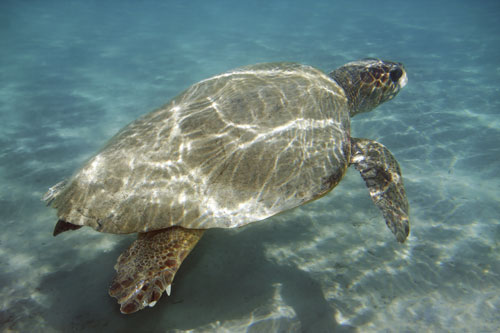Some Caretta caretta classified as endangered while others are not.
The Loggerhead sea turtle (Caretta caretta), long on the endangered species list (since 1978), has had its status reclassified by the National Marine Fisheries Service and the U.S. Fish and Wildlife Service by geographical location, effectively giving some loggerheads the endangered species classification and others the threatened classification.

Thinkstock
Loggerhead sea turtle protection status is now classified by geographic location.
Under the new change, the North Pacific population of turtles is listed as endangered along with four other groups around the world, while the Northwest Atlantic population, which covers the Southeast Atlantic and Gulf coasts have been deemed threatened. Conservation biologists are not happy about the change in designation. Chris Pincetich, a marine biologist with the Sea Turtle Restoration Project of the Turtle Island Restoration Network told the Miami Herald, “The failure to recognize Northwest Atlantic loggerheads are endangered ignores the massive impacts of the BP oil spill and increasing threats from shrimp trawl fisheries on this imperiled population. Fisheries in the United States were opposed to revising the status of the turtles along the east and Gulf coasts of the United States to endangered, and NMFS and USFS agreed to reverse their desire to list the animals in this region as endangered.
Some of the issues regarding loggerhead sea turtle mortality due to sea turtle by-catch have been mitigated with the use of turtle excluder devices on shrimp trawlers as well as the decrease in long line fishing due to declining fish stocks and a slowed economy. This in part gave the rise to change the classification of the sea turtles from endangered to threatened in certain localities. However, more needs to be done as not all shrimp trawlers have independent verifiers on board to determine the number of sea turtles safely released back into the oceans.
The loggerhead sea turtle can grow to about 7 feet in length and reach a weight of approximately 300lb. The turtle’s range includes the Atlantic and Pacific oceans, the Indian ocean and the Mediterranean Sea. The turtle reaches sexual maturity in as little as 17 (20 to 30 years is the norm) years and has an approximate lifespan of up to 67 years, though are known to live longer. The loggerhead sea turtle feeds mainly on invertebrates, including sponges, shellfish, jellyfish, shrimp, squid, and sea urchins.
On the east coast, the loggerhead sea turtle nests in Florida from May through August, with egg incubation lasting about 60 days. Around 100 eggs are laid in each nest, and of those, very few will survive into adulthood. According to the IUCN’s Marine Turtle Specialist Group, threats to loggerheads and other sea turtles include predation by raccoons, ghost crabs, birds, and sharks, and weather related events. Man made threats include harvesting of eggs and turtles for food, fishing net entanglements, coastal armoring, beach nourishment, and light pollution and marine pollution, such as the Gulf Oil Spill.

